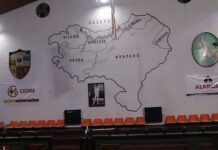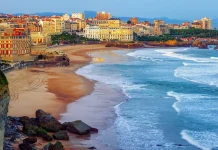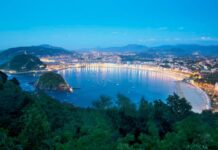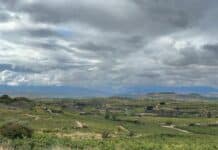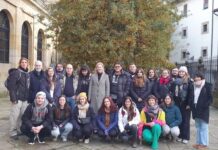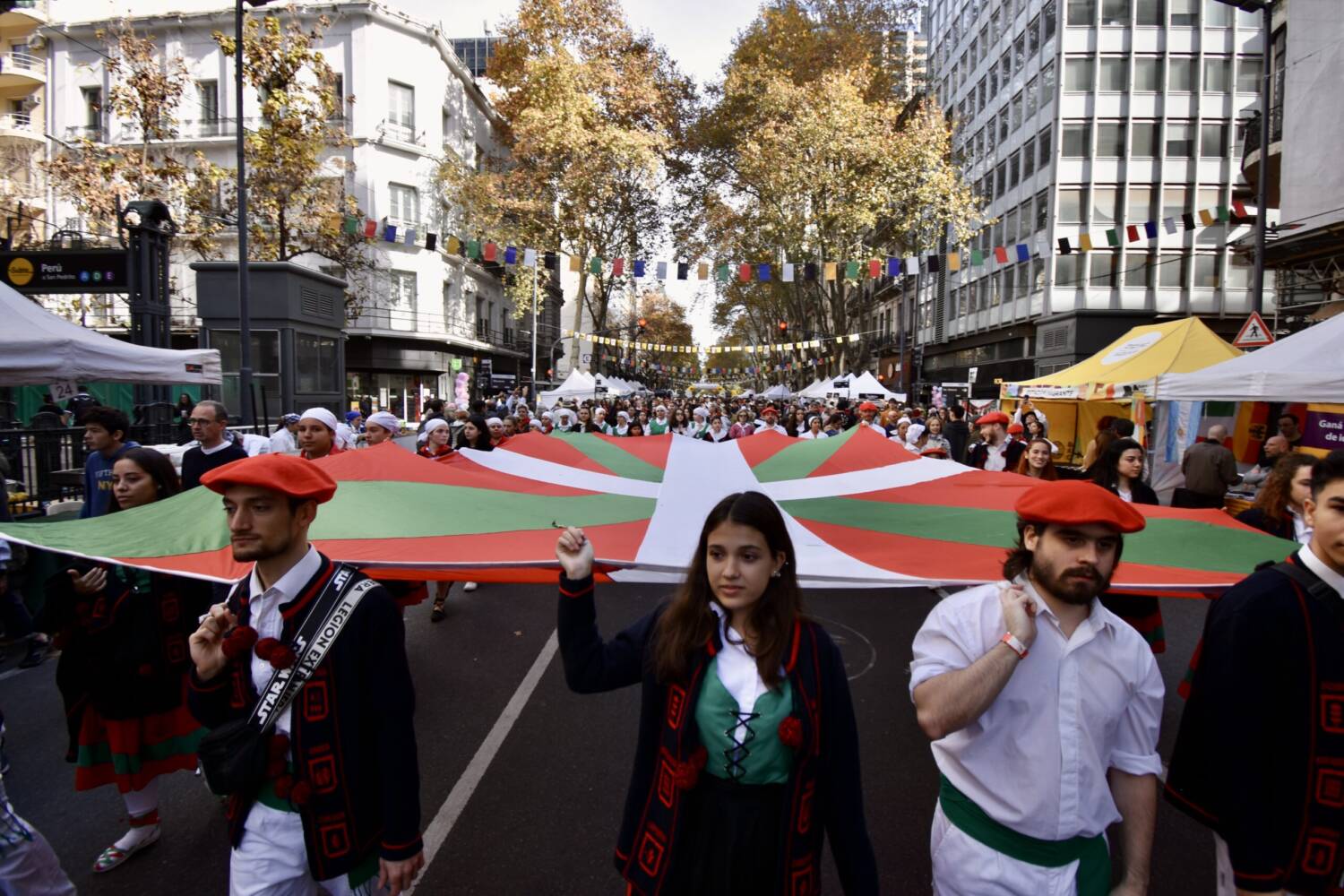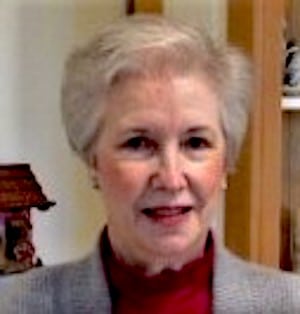Marie (Mirentxu) Amezaga Clark. I was born in Paris on May 7, 1938, the eldest daughter of Mercedes Iribarren and Vicente de Amezaga, Basque exiles originally from Las Arenas and Algorta (both in Getxo, Biscay), respectively. After my parents set sail for the Americas, escaping the Germans’ claws, at the age of two and a half I went to live with my aunt, uncle, and grandfather in Las Arenas, where I spent my childhood. I joined my parents in Montevideo, Uruguay, where I spent my teenage years. We ended up moving to Caracas, where I spent my youth. It was there that I met my future husband, Robert P. Clark. We were married and moved to Washington, DC. It was there where we had three children: Anne Miren, Kathleen, and Robert Vincent; I completed my studies at George Mason University with honors in the BIS program. Alongside a handful of other Basque residents in the Washington metro area, we created the Washington “Euskalerria” center on April 4, 1982, which unfortunately closed seven years later. I had the opportunity to write the book “Nere Aita,” in 1992 as part of the Basque Government’s “Americas and Euskaldunak” program. My husband and I have been married for 56 years and we have four grandchildren.
The General Assembly of the United Nations, in 2000, declared December 18th International Migrants’ Day. Marie (Mirentxu) Amezaga Clark, a “daughter” of this part of the Basque diaspora that had to abandon its homeland starting in 1937 because the Franco dictatorship, took advantage of the closeness of this date to recall the role of Basque migration in the history of the New World.
The presence of Basque there dates at least to the beginning of the 16th century. We say “at least” because, although there is no concrete proof, it is not unlikely that Basque whalers from both sides of the Pyrenees reached North America before that date.
By the start of the 17th century, the presence of a prosperous Basque community in South American was proven by the appearance of the first organization of the Basques in the New World: The Brotherhood of Our Lady of Aránzazu of Lima.
Since then, the Basques from both sides of the Pyrenees have left a deep and permanent mark on the history of societies throughout the New World. One bit of concrete evidence of this is that the husband of the author, Robert P. Clark, professor emeritus of political science at the George Mason University, provided us with an amazing article about the roles Basque played in the independence of the United States.
Because, let’s not forget, Basque society has been a land of emigrants for centuries. Whether searching for a better life or fleeing political persecutions or war or hunger, many hundreds of thousands of Basque left their homeland for a new country. And contrary to what we might be led to believe, their arrival was not was with welcome arms, nor was it free of tensions and issues.
International Migrants’ Day. Basque Emigrants
Marie (Mirentxu) Amezaga Clark
The General Assembly of the United Nations has declared December 18th to be International Migrants’ Day. This was proclaimed on December 4, 2000 by the UN General Assembly in Resolution 55/93, “Taking into account the large and increasing number of migrants in the world, Encouraged by the increasing interest of the international community in the effective and full protection of the human rights of all migrants, and underlining the need to make further efforts to ensure respect for the human rights and fundamental freedoms of all migrants.” Throughout history, migration has been an expression of individual bravery and determination to overcome adversity and to seek out a better life.
It is estimated that between 1830 and 1900, some 200,000 Basques emigrated to the New World.


The photo shows a model of the ship Monte Amboto, behind me, on display at the Bilbao Maritime Museum. “My ship” took me, at the age of nine, from Bilbao to Montevideo. I went by myself, on a journey like no other, to meet my parents and siblings.
In the middle of the 19th century, the Basque Country lost a great deal of its autonomy in the Carlist wars, so many Basques decided to leave their homeland. The Basques emigrated to many parts of the world. Those who reached the United States took part in the Gold Rush, and settled in California, Idaho, Wyoming, and Nevada. They arrived with the intention to work in the mines, but they had better luck and sheepherders.
The second generation of Basques decided not to continue with that life, and began to study other careers, but there was always a desire to keep their culture, language, and traditions alive, so they founded cultural centers wherever they gathered.
The large number of Basques who reached the Americas from the Basque Country have left their mark in the names they chose for the cities they discovered.
Ángel Urraza, a young man from Biscay who arrived shortly before the Mexican Revolution, prospered, and founded Euskadi, a tire company that is so emblematic in the country that even in the James Bond film Goldfinger, reference is made to it in a scene set in Mexico.
Agustín de Iturbide, the son of a Basque emigrant and the first emperor of Mexico, defined himself as “100% Basque.” It was he who adopted the tricolor flag of the first Mexican government, with the same green, white, and red we see today.
Perhaps the biggest name among Basque descendants in the independence of the New World republics was undoubtedly Simón Bolívar, a fifth-generation descendant of a Biscayan from Ziorta-Bolibar who emigrated to Venezuela at the end of the 16th century. In his youth, the Libertador traveled to the Basque Country to rediscover his roots, before becoming a key figure in the independence of several South American nations.
Notable personalities such as Sor Juana Inés de la Cruz, one of the most important literary figures in New Spain, son of Pedro de Asuaje, from Bergara, Gipuzkoa. She was an extraordinary writer, and a leading figure in Latin American literature in the 18th century, even including references to the Basque Country and some lines in the Basque language in her works.
Juan Sebastián Elcano, a Basque sailor who was the first to circumnavigate the globe, was born in Getaria, Gipuzkoa, and led the Magellan expedition around the world after Magellan himself had died, by taking command of the only ship, the Victoria, to survive of the five that had left. The first ship to circumnavigate the globe had been built at the shipyards in Ondarroa.
Aboard the three caravels that Christopher Columbus were many Basque crewmembers. We know that the La Pinta was captained by a man from Algorta, Biscay, by the name of Juan Quintero.
The Basques left their marks throughout the Americas, playing sports brought by immigrants, such as jai-alai, or Basque handball, to places like Florida and Cuba.
Basque cuisine is recognized internationally. In the western United States, hotels where Basque shepherds spend the winter months became popular. They would all eat together at long tables, oftentimes eating just one dish, which would be placed in the middle to be shared. Even today, Basque restaurants serve dishes this way, “home style” or “family style.”
In Mexico, one of their traditional Christmas dishes is bacalao a la vizcaina, or codfish Biscayan style. In Chile, several dishes are served with salsa vasca.
As for economic activities, in Argentina, the success of the dairy company La Vascongada, which was founded by Northern Basque Pedro Uthurralt in 1908 stands out. Several generations of Argentinians and Uruguayans enjoyed one of their star products: Vascolet brand chocolate milk.
One of the most representative brands of beer in Mexico, and around the world, has Basque DNA. The company that manufactures Corona is one of the largest breweries in the world, and was created by Braulio Iriarte, a Navarrese from Elozondo who migrated to Mexico when he was very young.
A place that best represents the Basque presence abroad are the eusko etxeak or Basque centers, of which the Basque Government has counted 200 worldwide. Of them, almost half are in Argentina.
These Basque centers initially arose as a place for mutual aid and shelter among the Basques who’d crossed the ocean for decades. Nowadays, they try to keep the Basque social and cultural identity alive by giving Basque language lessons, talks, concerts, dance and handball classes, among many other activities.
The presence and influence of the Basques on architecture can be seen in Caracas, among its many residential developments, as well as the Caracas Basque center in the El Paraíso development, which looks like a Basque cottage, designed by San Sebastian architect Miguel Salvador.
Boise, in the US state of Idaho, is considered the epicenter of the Basque diaspora in the United States, where several thousand people congregate every five years in the grand festival of Basque culture that is put on by the neighborhoods and Basque museums.
Header photo: the Basque community on parade in the 2023 BAC of the Basque Country, in Buenos Aires
Last Updated on Jan 13, 2025 by About Basque Country




